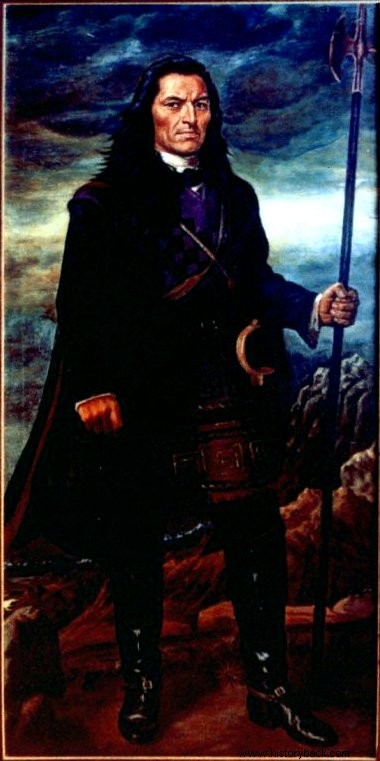Tupac Amaru II was a Peruvian revolutionary whose trajectory directly interfered in the process of independence in Spanish America.
He was the last king of the royal Inca dynasty. He was born in 1738, in Cuzco, and was assassinated in 1781, after the failure of the insurrection against the Spaniards.
The last Inca king is described as an elegant, charismatic, and cultured man. Educated by Jesuits, he is still considered a symbol of indigenous revolt. In the 20th century, he inspired revolutionaries such as Che Guevara himself .
 Tupac Amaru II oil painting
Tupac Amaru II oil painting
Biography
Tupac Amaru II had great prestige among indigenous people and also among the Spaniards. So much so, that he received the title of Marquis of Oropesa. Educated at the college of San Bernardo de Cuzco, he became head of Tungasuca, Surimana and Pampamarca.
A rich man, he had a large squad of mules and llamas, used to transport between cities. And it was the disagreement of the Spanish tax system that influenced, in 1780, the first rebellion led by Tupac Amaru II.
For mestizos and other residents of Spain's colonies, the corregidors weighed heavily in collecting taxes and were unfair in the distribution of goods and services.
The systems, called mitas and obrajes, instituted by the Spanish monarchy generated discontent. In these systems, the indigenous and mestizos worked in semi-slavery.
As a way of irrigating the public coffers, the Spanish crown reformed the tax collection system between 1776 and 1787. The new system increased the collection of taxes in ports connected to Spain, but ended up impoverishing other regions, such as Peru.
The cities, which were experiencing high growth, had to face an accentuated economic crisis due to the stagnation of the industry, the reduction in the circulation of money and, also, the fall in purchasing power resulting in a heavy tax burden.
The direct impact, considered the engine of the revolt against Spain, was on the poorer classes, who were punished with extreme violence. The rebels were considered disloyal to the King of Spain, Charles III.
In addition to violence, the indigenous people had to act more in the mitas system, which consisted of forced labor in the silver mines in exchange for freedom.
Even with the workload beyond the limit, the crown demanded greater participation in the mitas for the construction of houses, public buildings and the cultivation of coca and vines.
Forced to move from the mountains to the plains, the indigenous people went through a process called "climate aggression" and many died as a result of disease and corporal punishment.
The context was brought by Tupac Amaru II himself to the representatives of the crown in 1776. The complaints were not accepted and, in 1778, the first uprising against the mitas system took place, which was suppressed.
In the continuation of the system, on November 10, 1780, Mayor Antonio Arriaga was arrested and executed on the orders of Tupac Amaru II himself. In response, 1,200 men were sent to Cuzco, the leader would still have tried to negotiate the surrender of the city.
The revolt, however, had already spread and reached Argentina, reaching 60,000 Indians. This was the last major Spanish massacre before the final independence process. Spanish support consisted of 17,000 soldiers, better equipped and better equipped than the natives.
Tupac Amaru II's men were defeated on April 6, 1781. The leader was betrayed by the criollo Francisco Santa Cruz, who informed him and his family. So, on the 18th of May of that nano, the leader watched the execution of his family and then was murdered.
The indigenous leader had his tongue cut out and his limbs were tied to four horses that went in opposite directions. As death took too long, the executioner ordered the head to be cut off.
Today, Tupac Amaru II is remembered as the leader who started the process of independence for Peru and, with it, for all of Spanish America. It was considered plural politics, uniting Indians, mestizos, criollos and even Spaniards in the cause of emancipation.
Tupac Amaru Revolutionary Movement
The MRTA (Tupac Amaru Revolutionary Movement) was founded in 1982, in Peru, and was inspired by Tupac Amaru. From the extreme left, this armed movement promoted robberies and kidnapped rich people to ask for ransom and finance their activities.
It had representatives in Bolivia, Ecuador and Chile. Among his most remembered feats is the kidnapping of the Japanese ambassador in Chile. The diplomat was held at home along with 490 hostages, including judges, politicians, and businessmen.
The kidnapping lasted 126 days and aimed to free 442 Peruvian political prisoners. The 14 members of the movement were assassinated under the command of President Alberto Fujimori on April 22, 1997.
The group's hostages told the press that many tried to surrender but were killed in the same way. The action received severe criticism from the international community.
Keep searching!
- Incas
- First Peoples of America
- Spanish America
- Independence of Spanish America
